Failure modes and effect analysis which is applied to the electric powertrain system of Unmanned Ground Vehicle
04. Júl, 2011, Autor článku: Ferencey Viktor, Elektrotechnika
Ročník 4, číslo 7  Pridať príspevok
Pridať príspevok
![]() This paper deals with failure modes and effect analysis which is applied to the electric powertrain system of Unmanned Ground Vehicle. This work considers problem of reliability in main parts or components of electric motor/generator, power electronics and eletronic control system. Main part of the work will solve problems of crtitical nodes of UGV powertrain system.
This paper deals with failure modes and effect analysis which is applied to the electric powertrain system of Unmanned Ground Vehicle. This work considers problem of reliability in main parts or components of electric motor/generator, power electronics and eletronic control system. Main part of the work will solve problems of crtitical nodes of UGV powertrain system.
Introduction
This paper deals with failure modes and effect analysis which is applied to the electric powertrain system of Unmanned Ground Vehicle (Fig.1). The paper presents results of processed work in the own research feasibility study finished at TRL 2-3. UGV is designed for use in non-military crisis situations or in the military and security operations.
Failure Modes and Effects Analysis (FMEA) is a method to analyze potential reliability problems in the development cycle of the project, making it easier to take actions to overcome such issues, enhancing the reliability through design. FMEA is used to identify actions to mitigate the analyzed potential failure modes and their effect on the operations. Anticipating these failure modes, being the central step in the analysis, needs to be carried on extensively, in order to prepare a list of maximum potential failure modes.
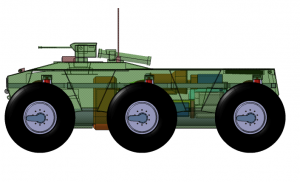
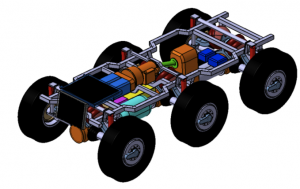
Fig.1: Unmanned Ground Vehicle
Characteristics of the FMEA analysis
- systematic, highly structured evaluation to determine the relationship of failure modes component team and experience to create a comprehensive report and ensure appropriate guarantees for problems in power system
- useable as a technique for system level and component level for the creation Risk assessment
- it is possible to apply to any well-defined system
- sometimes it is the system used by experts in the work of individual interviews and surveys individual items, but can also be transferred to an interdisciplinary team with different background and experience in groups of system documentation and survey data
- it is a technique that produces a qualitative description of potential power problems (failure modes, causes, consequences and countermeasures). It also produces lists of recommendations,necessary for risk reduction
- It is a technique which can estimate the quantitative frequency or consequences of failure
Definition of the implications for analysis
Hardware · approach (bottom-top), analyzed the consequences of failure the individual components of the system, or other systems that are its failure affected
Functional approach (from the top – in depth) – analyzed the consequences failure of system functions
At this stage of analysis is the choice of procedure (hardware or functional) needs analyze the magnitude of the consequences, which will include question analysis. It means exactly to what distance from the analyzed system, we will examine the consequences of failure. In the case of a hardware approach, we will examine the specific consequences of failure component. We ask, as the consequences for the surrounding subsystems will fail specific component. Always in this approach, but we ask only for component and the surrounding components. If we are talking specifically about the brake system, so we ask what effect will break the yoke of the surrounding parts of the braking system.
For functional analysis, we inquire about what the consequences to the surrounding subsystems, when the facility ceases to perform some action. For the analysis of the braking system is therefor we ask what impact the functionality of other systems will malfunction such as slow onset inhibiting effect (activity). Besides the basic border implications that the analysis should be included is often necessary include analysis of impact on the surrounding systems directly to the analyzed system unrelated. These include safety issues or environmental impacts disorders. If the plan of analysis used as part of the life-cycle analysis, important are also economic issues.
Procedure for implementation of FMEA analysis
The process for conducting a Failure Modes and Effects Analysis is summarized as follows:
- Describe product or process
- Define Functions
- Identify Potential Failure Modes
- Describe Effects of Failures
- Determine Causes
- Direction Methods or Current Controls
- Calculate Risks
- Take Action
- Assess Results
This process is applied to the various types of FMEAs, which either focus on the reliability and failure modes on components of electric motor/generator, power electronics and electronic control system. of Unmanned Ground Vehicle (Fig.2).
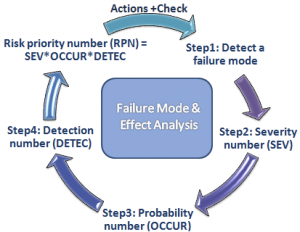
Fig.2: Procedure for implementation of FMEA analysis
Vehicle is powered by series hybrid electric propulsion, who be formed by two of master electric motor and joint with conjunctive speed-gearbox, small capacity internal combustion engine , generator, accumulator and necessary power electronics (Fig.3 ).
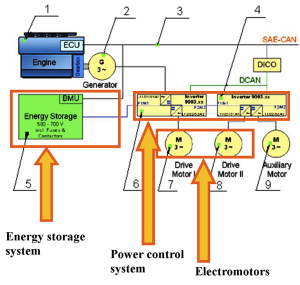
Fig.3: Powertrain wiring diagram with connectivity of components and critical nodes of powertrain
1 – Diesel internal combustion engine VW 2,0 TDi with ECU, 2 – Generator 1FV5139 – 6WS28, 3 – Communication interface SAE-CAN, 4 – Invertor of electromotor/generators Siemens, 5 –ZEBRA Battery Type Z37 – 620-ML3X-32, 6 – Invertor of powertrain Siemens , 7 – electromotor/generator Siemens 1PV5135-4WS28, 8 – Electromotor/generator Siemens 1PV5135-4WS28, 9 – Auxiliary electromotor
Tab.1a: FMEA analysis of UGV (Unmanned Ground Vehicle) electric powertrain system
| FMEA No.: | Component/Item | Function | Failure Mode | Failure Cause |
|---|---|---|---|---|
| 1 | Tractive DC Wiring | Energy transfer from/to Inverter | Positive pole lost isolation to the chassis structure | Wiring insulation degradation |
| 2 | Tractive DC Wiring | Energy transfer from/to Inverter | Negative pole lost isolation to the chassis structure | Wiring insulation degradation |
| 3 | Accumulator | Energy Storage | Accumulator/Cell temperature above data sheet specification | Accumulator damaged, possible temperature sensor malfunction |
| 4 | Accumulator | Energy Storage | Cell voltage above data sheet specification | Accumulator or battery management system degradation |
| 5 | Accumulator | Energy Storage | Cell voltage below data sheet specification | Accumulator degradation |
| 6 | Torque Encoder | Signaling the pedal position | Sensor 1 and Sensor 2 deliver different position values | Damage or valency of sensors |
| 7 | Motor Controller | Controlling the motor power | Motor Controller output stage short-circuit | Motor controller error |
| 8 | Insulation Monitoring Device | Monitoring the insulation of the tractive system | Insulation Monitoring Device lost connection to reference ground | Wiring or insulation monitor device is damaged |
| 9 | Insulation Monitoring Device | Monitoring the insulation of the tractive system | Insulation Monitoring Device lost power supply | Wiring or supply damaged |
| 10 | Insulation Monitoring Device | Monitoring the insulation of the tractive system | Insulation Monitoring Device is faulty | Wiring or insulation monitor device is in mallfunction |
| 11 | Battery Management System | Monitoring the accumulator condition | Battery Management System is faulty | Battery management system malfunction |
| 12 | Tractive AC Wiring | Energy transfer between motor and inverter | Any phase lost isolation to the chassis structure. | Wiring insulation degradation |
| 13 | Tratcive discharge system | Voltage dissipation in tractive system | Indication of HV in tractive system is not flashing properly. | Malfunction of discharge circuit inside inverter. Malfunction of measurement and indication system of vehicle. |
Tab.1b: FMEA analysis of UGV (Unmanned Ground Vehicle) electric powertrain system
| FMEA No.: | Local Failure Effect | Global Failure Effect | Sev | Occ | Det | RPN | Failure Detection |
|---|---|---|---|---|---|---|---|
| 1 | Potentially dangerous condition if operator touches the negative pole of the battery and the chassis | Possible chassis reference voltage potential change | 8 | 4 | 4 | 128 | Insulation resistance monitoring system. |
| 2 | Potentially dangerous condition if operator touches the positive pole of the battery and the chassis | Possible chassis reference voltage potential change | 8 | 3 | 1 | 24 | Insulation resistance monitoring system. |
| 3 | Dangerous condition if temperature exceeds accumulator limit | Accumulator cell degradation, loosing capacity. | 6 | 4 | 2 | 48 | Monitoring by BMS. Indication by LED. |
| 4 | Dangerous situation of possible explosion | Accumulator cell degradation, loosing capacity. | 6 | 4 | 1 | 24 | Monitoring by BMS. Indication by LED. |
| 5 | Insuficient power supply, indicating accumulator degradation | Accumulator cell degradation, loosing capacity. Power supply lost | 4 | 4 | 1 | 16 | Monitoring by BMS. Indication by LED. |
| 6 | Unsuitable torque signal delivered to processing unit | vehicle is not able to drive | 5 | 2 | 2 | 20 | Monitored by processing unit. vehicle does not react to padal possition. |
| 7 | Possible damage of motor inverter. | vehicle is not able to drive | 5 | 5 | 2 | 50 | Monitored and protected by motor inverter. |
| 8 | IMD sends failure signal to system | vehicle is not able to drive | 4 | 4 | 4 | 64 | Monitored by IMD. Indication by LED. |
| 9 | IMD is shuted down | vehicle is not able to drive | 2 | 2 | 2 | 8 | No OK signal from IMD, Indication by LED. |
| 10 | Potentially dangerous situation. Doubtful value of signal from IMD | Dangerous situation, possible HV on the chassis | 7 | 3 | 2 | 42 | No OK signal from IMD, Indication by LED. |
| 11 | Information about accumulator cells lost. | Information about accumulator cells lost. | 6 | 4 | 2 | 48 | Error message |
| 12 | Potentially dangerous condition if operator touches the chassis and reference ground | Possible HV on chassis. | 9 | 5 | 4 | 180 | Insulation resistance monitoring system. |
| 13 | Residual high voltage in tractive system | Vehicle is dangerous. Possible injury. | 7 | 4 | 2 | 56 | Self buit measurement and control units (MCU) and TSAL. |
Tab.3: Legend to the FMEA analysis modes ;
| Rating | Severity (Sev) Occurrence (Occ) Detection (Det) |
Rating | Severity (Sev) Occurrence (Occ) Detection (Det) |
|---|---|---|---|
| 1 | No effect, Failure occurrence is very unlikely, Certain detection of the failure | 6 | significant – the user recorded material malfunctioning equipment (eg in some situations) – use is not restricted, but the system remains functional and safe – partial failure, but functional great (significant) |
| 2 | very easy – the user will not be angry – error leads only to a very subtle reduction in use system | 7 | - the user can fully use product, is dissatisfied – error significantly affects the product – Functionality is significantly reduced |
| 3 | easy – the user will be easily annoyed – error leads to a subtle reduction in use | 8 | Extreme – the user is strongly dissatisfied – the product is broken, but nothing that should do (is safe) |
| 4 | small – user experience minor inconvenience in use equipment – small errors are reflected in the use of equipment | 9 | dangerous – potentially dangerous to the user – can not stop using the product without an accident culpable failure – compliance with government regulations on safety is questionable make-or-break |
| 5 | medium – User record medium inconvenience in use equipment – Medium errors are reflected in the use of equipment | 10 | Use results in risks to users – relative to the whole system has resulted in itsimmediate failure, Persistent failure occurrence, Failure cannot be detected |
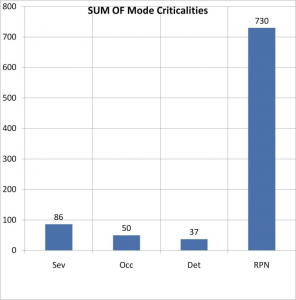
Fig.4: Summary of the Mode Criticalities of the UGVelectric powertrain system
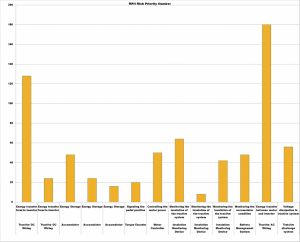
Fig.5: FMEA analysis of UGV (Unmanned Ground Vehicle) electric powertrain system in graph
Conclusion
In this paper, we have introduced a methodology to determine UGV reliabilty by FMEA analsys. FMEA analysis design can significantly reduce the time and cost, and this can provide a better understanding in UGV failure modes, which will help both designers and users to improve the reliability of UGV systems.
A failure cause is defined as a design weakness that may result in a failure. The potential causes for each failure mode should be identified and documented. The causes should be listed in technical terms and not in terms of symptoms (Tab.1,2, Fig.4). Examples of potential causes include:
- Improper torque applied
- Improper operating conditions
- Contamination
- Improper alignment
- Excessive loading
- Excessive voltage
The paper presents a basic demonstration of the FMEA analysis, which should be addressing more detailed life cycle analysis. The proposed method uses behavior modeling to simulate device operations and helps identify failure modes beyond component failures. The behavior model reasons about conditions that cause departures from normal operation and provides a framework for analyzing the consequences of failures. The paper shows how Advanced FMEA applies readily to the early stages of design and captures failure modes normally missed by conventional FMEA. The result is a systematic method capable of capturing a wider range of failure modes and effects early in the design cycle.
Acknowledgement
The paper was prepared with support of scientific VEGA grant, registration number 1/0627/10.
Bibliography
- Kováčova M., Ferencey V. : Projektovanie motorových vozidiel , STU Bratislava, 2007, ISBN 978-80-89313-05-1
- http://www.npd-solutions.com/fmea.html
- http://asq.org/learn-about-quality/process-analysis-tools/overview/fmea.html
- http://agrahya.wordpress.com/2010/03/07/failure-mode-and-effects-analysis-fmea/
- http://www.ipaslovakia.sk/slovnik_view.aspx?id_s=23
- Jack Yamaguchi: Hybrids for commerce. časopis Automotive Engineering, 11/2006, str. 66-69
- Jean L. Broge: Hybridized SUVs. časopis Automotive Engineering, 11/2006, str.72-73
- http://www.transportweekly.com/pages/en/news/articles/60474/
- http://automatizace.hw.cz/el-pohony/ART299-superkondenzator–princip-vlastnosti-pouziti.html
- http://www.fmeainfocentre.com/handbooks/umich.pdf
Co author of this paper are V. Staňák, M. Bugár FEI, STU v Bratislave, Kmech, Ilkovičova 3, 812 19 Bratislava, Slovak republic

